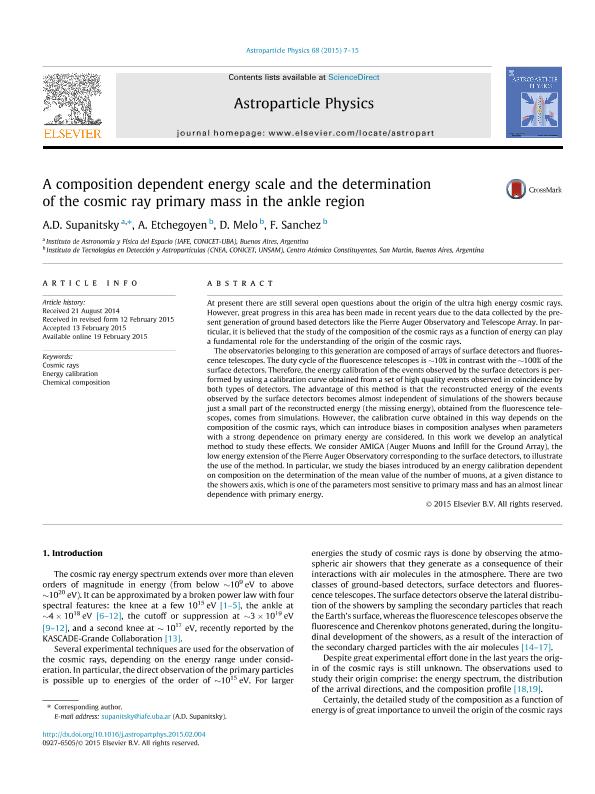Mostrar el registro sencillo del ítem
dc.contributor.author
Supanitsky, Alberto Daniel

dc.contributor.author
Sanchez, Federico Andrés

dc.contributor.author
Melo, Diego Gabriel

dc.contributor.author
Etchegoyen, Alberto

dc.date.available
2016-09-02T20:22:58Z
dc.date.issued
2015-02
dc.identifier.citation
Supanitsky, Alberto Daniel; Sanchez, Federico Andrés; Melo, Diego Gabriel; Etchegoyen, Alberto; A composition dependent energy scale and the determination of the cosmic ray primary mass in the ankle region; Elsevier; Astroparticle Physics; 68; 2-2015; 7-15
dc.identifier.issn
0927-6505
dc.identifier.uri
http://hdl.handle.net/11336/7411
dc.description.abstract
At present there are still several open questions about the origin of the ultra high energy cosmic rays. However, great progress in this area has been made in recent years due to the data collected by the present generation of ground based detectors like the Pierre Auger Observatory and Telescope Array. In particular, it is believed that the study of the composition of the cosmic rays as a function of energy can play a fundamental role for the understanding of the origin of the cosmic rays.
The observatories belonging to this generation are composed of arrays of surface detectors and fluorescence telescopes. The duty cycle of the fluorescence telescopes is ∼10% in contrast with the ∼100% of the surface detectors. Therefore, the energy calibration of the events observed by the surface detectors is performed by using a calibration curve obtained from a set of high quality events observed in coincidence by both types of detectors. The advantage of this method is that the reconstructed energy of the events observed by the surface detectors becomes almost independent of simulations of the showers because just a small part of the reconstructed energy (the missing energy), obtained from the fluorescence telescopes, comes from simulations. However, the calibration curve obtained in this way depends on the composition of the cosmic rays, which can introduce biases in composition analyses when parameters with a strong dependence on primary energy are considered. In this work we develop an analytical method to study these effects. We consider AMIGA (Auger Muons and Infill for the Ground Array), the low energy extension of the Pierre Auger Observatory corresponding to the surface detectors, to illustrate the use of the method. In particular, we study the biases introduced by an energy calibration dependent on composition on the determination of the mean value of the number of muons, at a given distance to the showers axis, which is one of the parameters most sensitive to primary mass and has an almost linear dependence with primary energy.
dc.format
application/pdf
dc.language.iso
eng
dc.publisher
Elsevier

dc.rights
info:eu-repo/semantics/openAccess
dc.rights.uri
https://creativecommons.org/licenses/by-nc-nd/2.5/ar/
dc.subject
Cosmic Rays
dc.subject
Energy Calibration
dc.subject
Chemical Composition
dc.subject.classification
Astronomía

dc.subject.classification
Ciencias Físicas

dc.subject.classification
CIENCIAS NATURALES Y EXACTAS

dc.subject.classification
Física de Partículas y Campos

dc.subject.classification
Ciencias Físicas

dc.subject.classification
CIENCIAS NATURALES Y EXACTAS

dc.title
A composition dependent energy scale and the determination of the cosmic ray primary mass in the ankle region
dc.type
info:eu-repo/semantics/article
dc.type
info:ar-repo/semantics/artículo
dc.type
info:eu-repo/semantics/publishedVersion
dc.date.updated
2016-07-22T14:06:45Z
dc.journal.volume
68
dc.journal.pagination
7-15
dc.journal.pais
Países Bajos

dc.journal.ciudad
Amsterdam
dc.description.fil
Fil: Supanitsky, Alberto Daniel. Consejo Nacional de Investigaciones Científicas y Técnicas. Oficina de Coordinación Administrativa Ciudad Universitaria. Instituto de Astronomía y Física del Espacio(i); Argentina
dc.description.fil
Fil: Sanchez, Federico Andrés. Consejo Nacional de Investigaciones Científicas y Técnicas. Oficina de Coordinación Administrativa Parque Centenario. Instituto de Tecnologías En Detección y Astropartículas; Argentina
dc.description.fil
Fil: Melo, Diego Gabriel. Consejo Nacional de Investigaciones Científicas y Técnicas. Oficina de Coordinación Administrativa Parque Centenario. Instituto de Tecnologías En Detección y Astropartículas; Argentina
dc.description.fil
Fil: Etchegoyen, Alberto. Consejo Nacional de Investigaciones Científicas y Técnicas. Oficina de Coordinación Administrativa Parque Centenario. Instituto de Tecnologías En Detección y Astropartículas; Argentina
dc.journal.title
Astroparticle Physics

dc.relation.alternativeid
info:eu-repo/semantics/altIdentifier/url/http://www.sciencedirect.com/science/article/pii/S0927650515000286
dc.relation.alternativeid
info:eu-repo/semantics/altIdentifier/doi/http://dx.doi.org/10.1016/j.astropartphys.2015.02.004
Archivos asociados
